| dc.contributor.author | Marlow, Weston A. | |
| dc.contributor.author | Carlton, Ashley K. | |
| dc.contributor.author | Yoon, Hyosang | |
| dc.contributor.author | Clark, James R. | |
| dc.contributor.author | Haughwout, Christian Alexander | |
| dc.contributor.author | Cahoy, Kerri | |
| dc.contributor.author | Males, Jared R. | |
| dc.contributor.author | Close, Laird M. | |
| dc.contributor.author | Morzinski, Katie M. | |
| dc.date.accessioned | 2019-08-02T19:01:32Z | |
| dc.date.available | 2019-08-02T19:01:32Z | |
| dc.date.issued | 2017-03 | |
| dc.date.submitted | 2016-11 | |
| dc.identifier.issn | 0022-4650 | |
| dc.identifier.issn | 1533-6794 | |
| dc.identifier.uri | https://hdl.handle.net/1721.1/121963 | |
| dc.description.abstract | In this study, the feasibility and utility of using a maneuverable nanosatellite laser guide star from a geostationary equatorial orbit have been assessed to enable ground-based, adaptive optics imaging of geosynchronous satellites with next-generation extremely large telescopes. The concept for a satellite guide star was first discussed in the literature by Greenaway and Clark in the early 1990s ("PHAROS: An Agile Satellite-Borne Laser Guidestar," Proceedings of SPIE, Vol. 2120, 1994, pp. 206-210), and expanded upon by Albert in 2012 ("Satellite-Mounted Light Sources as Photometric Calibration Standards for Ground-Based Telescopes," Astronomical Journal, Vol. 143, No. 1, 2012, p. 8). With a satellite-based laser as an adaptive optics guide star, the source laser does not need to scatter, and is well above atmospheric turbulence. When viewed from the ground through a turbulent atmosphere, the angular size of the satellite guide star is much smaller than a backscattered source. Advances in small-satellite technology and capability allowed the revisiting of the concept on a 6UCubeSat, measuring 10 × 20 × 30 cm. It is shown that a system that uses a satellite-based laser transmitter can be relatively low power (∼1 W transmit power) and operated intermittently. Although the preliminary analysis indicates that a single satellite guide star cannot be used for observing multiple astronomical targets, it will only require a little propellant to relocate within the geosynchronous belt. Results of a design study on the feasibility of a small-satellite guide star have been presented, and the potential benefits to astronomical imaging and to the larger space situational awareness community have been highlighted. | en_US |
| dc.description.sponsorship | United States. Air Force Office of Scientific Research (Contract FA8721-05-C-0002) | en_US |
| dc.description.sponsorship | Air Force Office of Scientific Research (Contract FA8702-15-D-0001) | en_US |
| dc.language.iso | en | |
| dc.publisher | American Institute of Aeronautics and Astronautics (AIAA) | en_US |
| dc.relation.isversionof | http://dx.doi.org/10.2514/1.a33680 | en_US |
| dc.rights | Creative Commons Attribution-Noncommercial-Share Alike | en_US |
| dc.rights.uri | http://creativecommons.org/licenses/by-nc-sa/4.0/ | en_US |
| dc.source | Prof. Cahoy via Barbara Williams | en_US |
| dc.title | Laser-Guide-Star Satellite for Ground-Based Adaptive Optics Imaging of Geosynchronous Satellites | en_US |
| dc.type | Article | en_US |
| dc.identifier.citation | Marlow, Weston A. et al. "Laser-Guide-Star Satellite for Ground-Based Adaptive Optics Imaging of Geosynchronous Satellites." Journal of Spacecraft and Rockets 53, 4 (March 2017): A33680 © 2016 Massachusetts Institute of Technology | en_US |
| dc.contributor.department | Massachusetts Institute of Technology. Department of Aeronautics and Astronautics | en_US |
| dc.contributor.department | Lincoln Laboratory | en_US |
| dc.relation.journal | Journal of Spacecraft and Rockets | en_US |
| dc.eprint.version | Original manuscript | en_US |
| dc.type.uri | http://purl.org/eprint/type/JournalArticle | en_US |
| eprint.status | http://purl.org/eprint/status/NonPeerReviewed | en_US |
| dc.date.updated | 2019-08-02T17:57:35Z | |
| dspace.date.submission | 2019-08-02T17:57:37Z | |
| mit.journal.volume | 54 | en_US |
| mit.journal.issue | 3 | en_US |
